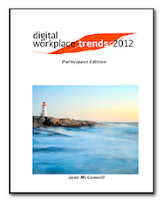There are many SharePoint conferences out there. Do we really need another one? My colleagues and I at Entopic found many conferences address SharePoint from a technology and developer perspective. Which is great. There is clearly a market for this. However, we wondered if there are also conferences that address the business- and user-side of SharePoint. We found only a couple world-wide. For this reason we thought it would be good to organize a SharePoint conference with a business focus. And apparently more people were looking for something like this. There were 300+ attendees.
Symon Garfield kicked off the conference with a keynote about how to implement SharePoint successfully. Symon discussed several reasons why implementations fail. Like policitcs, not understanding SharePoint, no feeling for information and knowledge management, no senior management support, etc.
Symon proposed a four step approach to a successful implementation: governance (beware of the tech-focus!), strategy and business case (connect Sharepoint to business processes!), business architecture (know the internal workings of the platform) and transition (make sure you have an adoption plan!).
This last steps leads us directly to the second keynote of the conference by Sam Marshall. Sam's keynote went deeply into SharePoint adoption. He started out by asking the audience who's Sharepoint implementation has a larger 'human' than IT budget. Hardly anybody raised their hand... Sam shared the MARS model with us and discussed it in detail. The model has 4 steps:
- Mandated
- Accepted
- Rewarding
- Stimulating
Sam showed how these steps could work when organizations would like to have employees fill in their profile.
I enjoyed Sam's talk. I liked the way he drilled deeply into adoption, clearly showing us all that adoption is not easy and should not be an afterthought.
There were two rounds of breakouts. The breakouts were about Sharepoint for websites, intranet, internal social networking, Sharepoint 2013, etc.
I went to two interesting breakouts. One was lead by Jan van Veen and was about how he positioned their local intranet in a world-wide SharePoint intranet. The other was by Ellen van Aken and she showed how SharePoint can drive business value by supporting business processes.
All conference slides can be found here.



